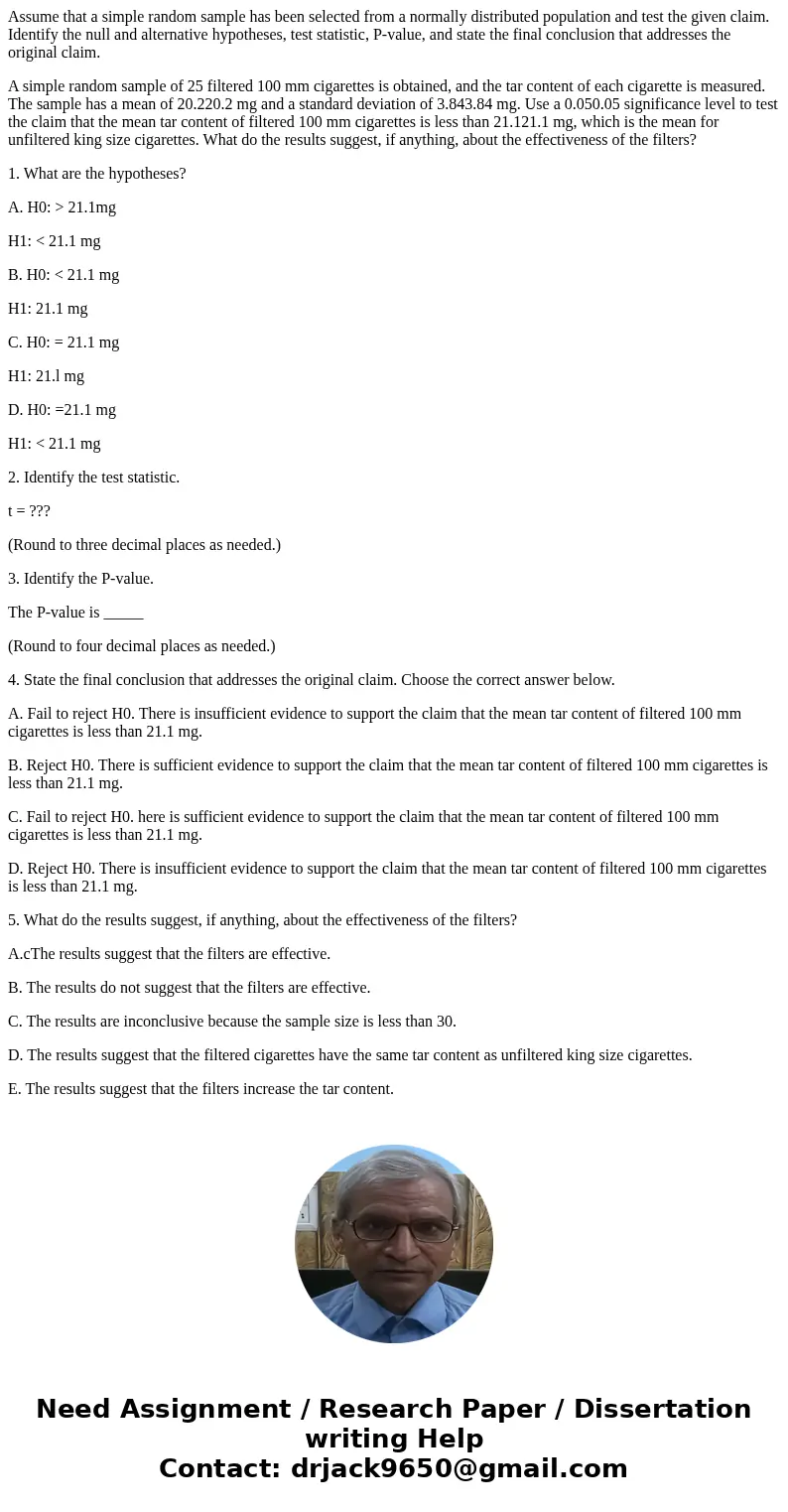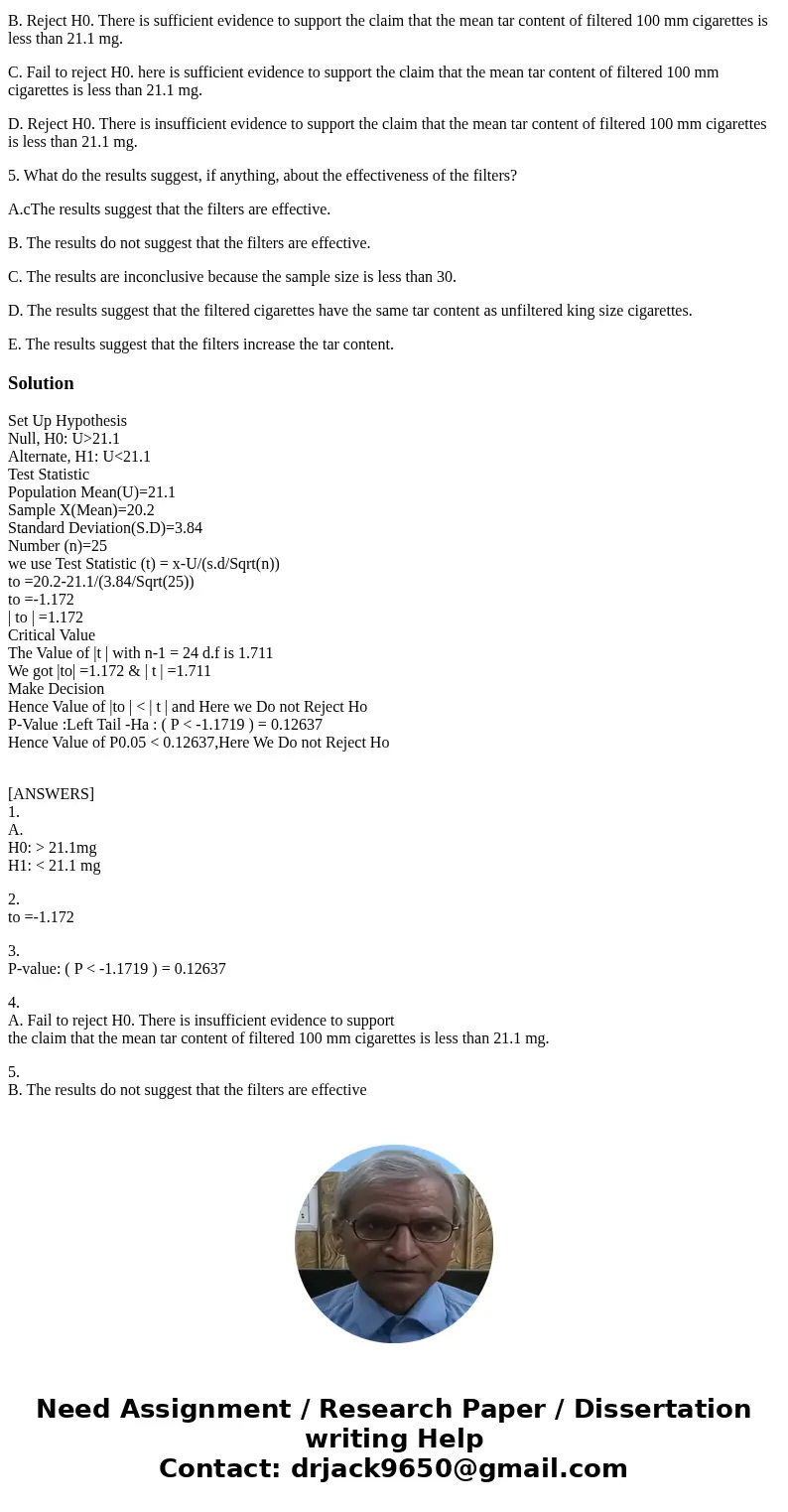Assume that a simple random sample has been selected from a
Assume that a simple random sample has been selected from a normally distributed population and test the given claim. Identify the null and alternative hypotheses, test statistic, P-value, and state the final conclusion that addresses the original claim.
A simple random sample of 25 filtered 100 mm cigarettes is obtained, and the tar content of each cigarette is measured. The sample has a mean of 20.220.2 mg and a standard deviation of 3.843.84 mg. Use a 0.050.05 significance level to test the claim that the mean tar content of filtered 100 mm cigarettes is less than 21.121.1 mg, which is the mean for unfiltered king size cigarettes. What do the results suggest, if anything, about the effectiveness of the filters?
1. What are the hypotheses?
A. H0: > 21.1mg
H1: < 21.1 mg
B. H0: < 21.1 mg
H1: 21.1 mg
C. H0: = 21.1 mg
H1: 21.l mg
D. H0: =21.1 mg
H1: < 21.1 mg
2. Identify the test statistic.
t = ???
(Round to three decimal places as needed.)
3. Identify the P-value.
The P-value is _____
(Round to four decimal places as needed.)
4. State the final conclusion that addresses the original claim. Choose the correct answer below.
A. Fail to reject H0. There is insufficient evidence to support the claim that the mean tar content of filtered 100 mm cigarettes is less than 21.1 mg.
B. Reject H0. There is sufficient evidence to support the claim that the mean tar content of filtered 100 mm cigarettes is less than 21.1 mg.
C. Fail to reject H0. here is sufficient evidence to support the claim that the mean tar content of filtered 100 mm cigarettes is less than 21.1 mg.
D. Reject H0. There is insufficient evidence to support the claim that the mean tar content of filtered 100 mm cigarettes is less than 21.1 mg.
5. What do the results suggest, if anything, about the effectiveness of the filters?
A.cThe results suggest that the filters are effective.
B. The results do not suggest that the filters are effective.
C. The results are inconclusive because the sample size is less than 30.
D. The results suggest that the filtered cigarettes have the same tar content as unfiltered king size cigarettes.
E. The results suggest that the filters increase the tar content.
Solution
Set Up Hypothesis
Null, H0: U>21.1
Alternate, H1: U<21.1
Test Statistic
Population Mean(U)=21.1
Sample X(Mean)=20.2
Standard Deviation(S.D)=3.84
Number (n)=25
we use Test Statistic (t) = x-U/(s.d/Sqrt(n))
to =20.2-21.1/(3.84/Sqrt(25))
to =-1.172
| to | =1.172
Critical Value
The Value of |t | with n-1 = 24 d.f is 1.711
We got |to| =1.172 & | t | =1.711
Make Decision
Hence Value of |to | < | t | and Here we Do not Reject Ho
P-Value :Left Tail -Ha : ( P < -1.1719 ) = 0.12637
Hence Value of P0.05 < 0.12637,Here We Do not Reject Ho
[ANSWERS]
1.
A.
H0: > 21.1mg
H1: < 21.1 mg
2.
to =-1.172
3.
P-value: ( P < -1.1719 ) = 0.12637
4.
A. Fail to reject H0. There is insufficient evidence to support
the claim that the mean tar content of filtered 100 mm cigarettes is less than 21.1 mg.
5.
B. The results do not suggest that the filters are effective


 Homework Sourse
Homework Sourse